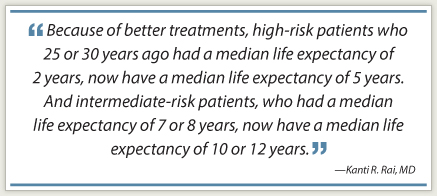
Four decades ago, Kanti R. Rai, MD, was determined to figure out why some of his patients with chronic lymphocytic leukemia (CLL) died within 2 years after their diagnosis, while others lived for 20 or even 30 years. At the time, Dr. Rai was a young scientist doing research in leukemia at Brookhaven National Laboratory in Upton, New York. He started examining the records of over 100 of his patients, separating them into three categories: those who died rapidly after diagnosis, those who were alive 10 to 15 years beyond their diagnosis, and those who fell in between.
Soon, patterns began to emerge. Dr. Rai found that patients with the lowest red corpuscle and platelet counts had the poorest survival rates (high risk); those with normal platelet and red blood counts had the best chances of long survival (low risk); and those with little bone marrow involvement but who had swollen lymph nodes, spleen, or liver fell in the middle (intermediate risk).
Today, the Rai System is one of the gold standards for staging CLL and determining which patients should be treated immediately and which ones should be put on a watch-and-wait approach. The staging system is now also used to help investigators choose which CLL patients are likely to have the best outcomes in clinical trials testing new agents.
Dr. Rai is now Director of the Chronic Lymphocytic Leukemia Research and Treatment Program at North Shore–Long Island Jewish Health System and the Joel Finkelstein Cancer Foundation Professor of Medicine and Professor of Molecular Medicine at Hofstra North Shore–LIJ School of Medicine. In June, he will be recognized for his work in cancer research and for his impact on the treatment of patients with cancer with the David A. Karnofsky Memorial Award and Lecture, which will be presented at ASCO’s Annual Meeting.
Dr. Rai talked with The ASCO Post about the progress that has been made in more effective treatments for CLL, which have resulted in doubling median overall survival rates, and new therapies being tested in clinical trials.
Prognostic Factors
What advances have been made since the development of your staging system in identifying additional prognostic factors that predict which patients with chronic lymphocytic leukemia will have progressive disease?
In 1999, my colleague at The Feinstein Institute for Medical Research, Nicholas Chiorazzi, MD, and his team, discovered molecular distinctions within the groups of CLL patients with good prognosis and bad prognosis. A good-prognosis/low-risk-group patient can have mutated IgVH genes on the lymphocyte or unmutated IgVH genes. Patients with the unmutated genes tended to have a worse prognosis, and the patients with the mutated genes tended to have an excellent prognosis. So, within each of the three categories of our staging system, we could improve these prognostic factors. For example, patients in the low-risk group with mutated IgVH genes could be assured that they were not likely to die from their disease, whereas low-risk patients with IgVH unmutated genes are the ones who in 5 or 10 years are likely to need chemotherapy.
Similarly, within the high-risk group, as well as in the intermediate-risk group, patients with IgVH mutations had a better prognosis than those with unmutated IgVH.
Watch-and-Wait Approach
Is watch-and-wait still an appropriate strategy for asymptomatic patients, or is there an advantage to early treatment in CLL?
The answer is complicated. To be categorical, yes, watch-and-wait is still appropriate for some patients with chronic lymphocytic leukemia. But the numbers of people who are likely to be kept on observation alone are decreasing, because the molecular prognostic factors that have been added to the clinical staging factors are enabling us to identify prospectively those patients in the good prognosis group or in the intermediate prognosis group (whom we normally assign to watch-and-wait) if they happen to have unmutated IgVH genes or are ZAP-70–positive or CD38-positive.
ZAP-70–negative patients also have as good a prognosis as patients who have mutated IgVH genes or are CD38-negative, or have chromosomal abnormalities like 13q deletion. So if patients in the low-risk group have any of these good prognostic markers, then we feel a greater sense of security keeping them on observation. Whereas if patients in the intermediate-risk group have negative prognostic markers, such as trisomy 12 or 11q deletion, then we do not feel comfortable keeping them on watchful waiting and want to get control of their disease right away. Therefore, we are shrinking the numbers of people kept on observation.
Novel Agents
Although alkylating agents such as chlorambucil (Leukeran) or cyclophosphamide are still used in the front-line treatment of CLL, they are being combined with newer agents such as FCR (fludarabine, cyclophosphamide, and rituximab [Rituxan]) and the immunomodulatory agent lenalidomide (Revlimid) and are achieving complete responses in a higher percentage of patients. What are some new therapies in clinical trials in the relapsed/refractory setting?
There are two novel kinase inhibitors that are being investigated in clinical studies that look promising as effective therapies for relapsed or refractory CLL. One is PCI-32765, which is the first drug to target Bruton’s tyrosine kinase (Btk), and the other agent is CAL-101 (GS-1101), which targets PI3K-delta. Both work on the B-cell receptor in CLL, which is a critical receptor that controls the signaling, proliferation, and survival of leukemic cells.
In clinical studies of CAL-101, patients with advanced disease, in whom standard treatment failed, showed major improvement in the size of their greatly enlarged lymph nodes and spleen. But at the same time the drug pushed out all the leukemic cells from the lymph nodes and poured them into the circulating blood, so the white corpuscle number—which, usually, in a CLL patient may be between 75,000/μL and 100,000/μL—shot up to between 400,000/μL and 500,000/μL, and that was frightening. With continued use of CAL-101, the lymph nodes continued to remain small and the white count started to go down.
PCI-32765 had exactly the same kind of initial results when used as a single agent in refractory CLL patients. Both of these drugs are continuing in clinical trials. But now the emphasis is not on them as single agents but in combination with rituximab, ofatumumab (Arzerra), bendamustine (Treanda), or fludarabine. These agents are making the future for patients with advanced CLL much more optimistic, but we still have a few more years to go with ongoing clinical trials before we can claim victory.
Gene Therapy
Last year, researchers at the University of Pennsylvania published results of a pilot study of three patients with advanced CLL treated with genetically engineered versions of their own T cells, which resulted in sustained remissions of up to 1 year. How promising is gene therapy in CLL?
That trial had an extremely dramatic result. This type of gene therapy reprograms a patient’s own T cells to recognize B cells so that when the T cells were put back into the patient’s veins, they went on a search-and-destroy mission to systematically find and kill B lymphocytes (leukemic cells in CLL are B lymphocytes). These reprogrammed T cells continued to multiply in the patient’s body, so they remained a powerful tool against the leukemic cells. That was an absolutely amazing study result, but when you manipulate cells in the lab and then put them back into the patient along with a virus as a vector, there is the potential for all kinds of catastrophic events to occur, including death.
Everybody who is interested in curing CLL is getting in on this treatment-bandwagon, but unfortunately, this strategy is not simple. It’s not a pill that you give to a patient; it requires a lot of checks and balances, and it’s a complex treatment. But the researchers at the University of Pennsylvania are proceeding in a very systematic manner, and I believe they plan to treat 12 patients this year—not just patients with CLL but patients with other B-cell malignancies as well.
Impact on Survival
Are the new therapies that you mentioned earlier extending overall survival in CLL patients?
 Yes, there is no question about this. All these newer drugs, including rituximab and fludarabine in combination with cyclophosphamide, as well as bendamustine, alemtuzumab (Campath), and lenalidomide (which is not yet approved for CLL), have resulted in a marked degree of improvement in the overall life expectancy of people with chronic lymphocytic leukemia. Because of these better treatments beyond chlorambucil, high-risk patients who 25 or 30 years ago had a median life expectancy of 2 years, now have a median life expectancy of 5 years. And the intermediate-risk patients, who had a median life expectancy of 7 or 8 years, now have a median life expectancy of 10 or 12 years. So across the board there has been an improvement in life expectancy, and you have to give credit to improved treatment.
Yes, there is no question about this. All these newer drugs, including rituximab and fludarabine in combination with cyclophosphamide, as well as bendamustine, alemtuzumab (Campath), and lenalidomide (which is not yet approved for CLL), have resulted in a marked degree of improvement in the overall life expectancy of people with chronic lymphocytic leukemia. Because of these better treatments beyond chlorambucil, high-risk patients who 25 or 30 years ago had a median life expectancy of 2 years, now have a median life expectancy of 5 years. And the intermediate-risk patients, who had a median life expectancy of 7 or 8 years, now have a median life expectancy of 10 or 12 years. So across the board there has been an improvement in life expectancy, and you have to give credit to improved treatment.
Stem Cell Transplantation
With these novel therapies in use, what is the role of stem cell transplant?
There is still a role for stem cell transplant in CLL, but we use it selectively. Unfortunately, some people still do not respond well to the available chemotherapeutic agents. If we are fortunate and these patients have an HLA-compatible donor, then it is prudent to give them an allogeneic transplant with reduced-intensity conditioning chemotherapy. A number of people who were given a “mini-allo” transplant are alive and well today but would have died if not for their transplant. ■
Disclosure: Dr. Rai serves on the medical advisory boards of Celgene, Cephalon, and Genentech.

